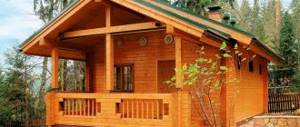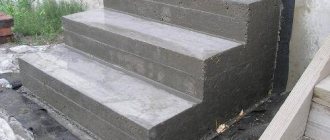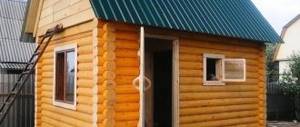In Rus', baths were called differently: istka, lazne, soap. The healing properties of water, steam, and hot stones were known to Russian people for a long time, so bathhouses in Rus' were able to be built everywhere.
The love for cleanliness and healing bath procedures is still alive in us. Consequently, baths are an integral part in the construction of a country house.
In this article you will learn how to properly build a Russian bathhouse and what mistakes should not be made during its construction.
Helpful information:
- Interior options for a wooden bathhouse
- How to choose a log sauna project
- 10 mistakes when installing electric heated floors
- Brick stoves for a bath: everything you need to know
- Roof for a bath: choice and nuances
- Finnish sauna stoves: what to choose?
If you want to get a house or bathhouse in perfect quality, and save time on learning technologies, then order from an experienced company. Specialists are good at building objects of any level of complexity.
Laying the foundation
Once you have decided on the size and location of the future bathhouse, you can begin the construction process. In most cases, a columnar or strip foundation is sufficient for its construction. The latter is durable and resistant to soil displacement, but it is more difficult to erect, it is more massive and requires more materials. The strip base is ideal for buildings made of brick or wood.
When building a Russian bathhouse with your own hands, you need to think about what kind of foundation you will need for it. In any of the options, you will need to dig trenches along the entire perimeter of the building, fill their bottom with a sand cushion, then water it and compact it thoroughly. When pouring a concrete layer, you need to ensure that the top level of the layer is above the zero level. The surface must be carefully leveled and supplemented with a waterproofing layer, for example, using roofing felt and bitumen mastic. The base must be strengthened with reinforcement.
If the building is compact and not too massive, you can choose a columnar foundation that will not put a strong load on the ground. In this option, the pillars are located in the corners of the future building, in places where the external and internal walls will intersect with each other, where there will be places of greatest load. Usually the distance between them is one and a half to two meters. The pillars are connected to each other by a grillage, which gives reliability to the base of the building. The surface of the base needs to be leveled and waterproofed, not forgetting to leave space for the base of the stove.
The stove should be positioned so that all rooms are heated at the same time.
How to take a steam bath in a Russian sauna without mistakes
The best option would be not to let the organization of steam in a Russian bath take its course, but to properly heat the bathhouse and steam yourself or with a group, while the real light steam of a Russian bath is in the steam room. Visiting the steam room several times is also quite possible, but before each time the procedure for equalizing the humidity and temperature will have to be repeated anew. How quickly the steam in the steam room will be “corrected” for a new session depends on its design and proper management of the heater and vent.
After entering the steam room, after 20-30 minutes, the body adapts to the temperature and humidity, and a feeling of cooling of the steam room will appear. With good thermal insulation of the walls and a high-quality stone stove, good steam will last for an hour or two. In a bathhouse with a steel potbelly stove, real steam from a Russian steam room will last no more than half an hour.
Common Mistakes
A typical error in steam management is flooding the heater with excess water. In this case, something like a Turkish hammam is formed in the Russian bathhouse for a short time. After another ten minutes, the steam room will begin to cool quickly, and due to the high humidity, dampness and discomfort will appear. It’s even worse if you heat the heater white-hot, add water to the heater, and fill the steam room with a hot, humid cloud that makes it impossible to breathe.
In the first case, you should leave the steam room, correct the operation of the stove and remove the water from the heater. After adding a new portion and heating the oven, as the steam room warms up again, it is recommended to open the valve and remove most of the steam with cooled air from the steam room. Having thoroughly added heat to the atmosphere of the steam room, they enter the room and in small portions increase the water content in the air of the room.
Sometimes the work of pouring hot water onto the stones is replaced with an aluminum flask holding a couple of liters of water, from which water drips through the unscrewed cap onto the hot stones of the stove.
Advice! Particularly effective will be the combination of watering the stones with water and fanning the hot heater with a towel or piece of plywood. Some masters are able to organize real light steam, typical of a Russian bath, in 10-15 minutes.
In the second case, it is better to ventilate part of the humid and boiling atmosphere from the steam room. The temperature in the Russian bath will drop and the humidity will level out. You can open the doors to the dressing room and wait until the dry air from the bathhouse premises expels the hot cloud into the ventilation.
The secret of easy steam
One of the most popular options is the combination of a sauna and a Russian bath in one steam room. Not everyone likes this method of steaming, but in many cases it is suitable if people in a group like different temperature conditions.
The essence of the method is as follows. First, the steam room is heated to the highest possible temperature and low humidity. Those who love the Finnish “brazier” can steam in such a sauna. During this time, the bulk of the stone in the stove warms up to the maximum, then you need to open the ventilation of the steam room while simultaneously adding humidity by watering the heater with small portions of hot water.
If the working windows of the supply and exhaust ventilation in the steam room are arranged correctly, excess steam will be removed from the room, and a standard level of humidity will be formed in the steam room. Slightly elevated air temperatures will quickly drop to an acceptable 60-65°C.
The most important thing is that after a hot hundred-degree atmosphere, conditions of high humidity and low temperature will seem much more comfortable and pleasant. But to enjoy such a contrast, you need to have normal blood pressure and a healthy heart.
Contraindications and possible harm
Despite all the benefits, the procedure also has serious limitations. Contraindications to visiting the steam room are as follows.
- Pathologies of the epidermis and rashes on the skin. Even if you have small pimples, you cannot steam, otherwise an abscess will arise with all the ensuing (literally and figuratively) consequences.
- Cardiovascular and pulmonary failure. It is also recommended that people suffering from sexually transmitted pathologies, pneumonia, bronchitis, epilepsy and cancer, both malignant and benign, refrain from visiting the bathhouse.
- Children's age up to 5 years. Everything is clear here - the baby’s body is not yet able to withstand such temperature overloads. Elderly people can only take a steam bath after a doctor’s permission.
- The period of bearing a baby and breastfeeding.
The procedure itself does not cause harm to health if there are no contraindications to its implementation and if you know how to take a steam bath in a Russian bath and what attributes to take with you to the steam room.
Firewood harvesting
In village baths, it is recommended to prepare a sufficient amount of firewood in advance in the form of a small woodpile directly in the steam room. Such preparation saves those steaming from the need to constantly bring in missing firewood from the street, which can be especially problematic in winter. Among other things, dry fuel flares up better and can provide good heating of the room.
Break between visits to the steam room
You need to spend the same amount of time outside the steam room as in it, so breaks are approximately 10-20 minutes.
After the steam room, you can take a cool shower, swim in the pool, but if you are hardening yourself and can easily tolerate temperature changes, then douse yourself with ice water. Are you steaming in winter? Go outside and wipe yourself off with snow! This procedure perfectly invigorates, improves mood and strengthens the immune system. But it is important that the body is prepared for it. If you have never done this before, it is better to limit yourself to a shower at first, gradually increasing the difference in temperature conditions in the steam room and shower.
An excellent option would also be to carry out cosmetic procedures; this is the main activity of women in the bathhouse. In the steam room, the pores of the skin open as much as possible, so it’s time to clean them with a scrub. Apply the product to the skin with massaging movements, leave it for 5-10 minutes so that the beneficial substances have time to be absorbed, and rinse.
After this procedure, the skin will become clean, soft and velvety. And if you use an anti-cellulite scrub, you will notice how the epidermis has become more elastic and toned.
You can also use a face and body mask in the bath. It should be applied to the skin in a thick layer, also left for 5-10 minutes and rinsed off.
After all the procedures, dry yourself with a towel and rest a little: drink tea, watch TV, chat.
We build walls
Construction of Russian baths with your own hands is possible from any materials. Since ancient times, timber or logs have been considered the best solutions. They are used very often in the construction of baths, since the room provides an ideal microclimate, and the naturalness of the wood once again emphasizes the harmony of all buildings. You need to choose logs of the same diameter. Sanding plays an important role in achieving a harmonious appearance of the structure. The stability of the connection is ensured by spikes that go 2-3 cm into the material.
Timber baths are built much faster, and they also shrink very little. Treatment of the lower five crowns with antiseptic agents is required. Since there are gaps between the beams or logs, they need to be insulated to achieve greater tightness, using dry moss, tow, felt, and hemp. Moreover, the joints must be processed twice: the first time immediately after the construction of the bathhouse, and the second time when the walls shrink. The construction of houses and baths from is a wide selection of design solutions that will appeal to everyone who wants to create a unified architectural ensemble on their site.
Traditional and exotic species
Throughout the history of the bathhouse, hundreds of ways to add variety to steam have been tried. Some, due to their availability, have become traditional, others have remained exotic curiosities, used less frequently.
Traditional varieties include flavors familiar to many:
- oak;
- birch;
- pub;
- leavened;
- juniper.
There are much more exotic species due to the fact that they are not as loved as the familiar ones or have been forgotten:
- mustard;
- worthless;
- garlic;
- sage;
- oregano;
- jasmine;
- a collection of tansy flowers, poplar buds and bison leaves;
- St. John's wort and many others.
Choosing a place for a bath
When designing a bathhouse, you should pay special attention to the location of the facility so that problems do not arise during operation. For example, you should not place the building in close proximity to a body of water. During high water periods, flooding is possible, the consequences of which negatively affect the wood. Also a bad choice would be a site adjacent to the road.
The building can be erected separately or adjacent to the house or outbuildings. When resolving this issue, it is necessary to take into account the availability of sewerage, water supply and other communications. But one should not neglect the rules that prohibit the installation of a bathhouse closer than 20 meters from wells and wells.
If the steam room is attached to a house or other buildings, all fire safety measures must be taken into account during construction.
The ideal place for a bathhouse is considered to be the back yard on the south side. So there will be enough sun rays, and the wind will not interfere with a pleasant pastime.
Steaming brooms
The water in which the brooms were steamed retains a large amount of useful substances, so this infusion is recommended to be used for rinsing hair. To soften such water, brunettes can add a small amount of table vinegar, and blondes can add chamomile infusion.
This infusion is perfect for dousing. In this case, there is no need to wash it off the body.
Bathhouse layout. We build a bathhouse ourselves
The size of the bathhouse is determined based on the size of the area. Usually such a structure is made 6x6m or 6x4m, but if the area is very small, then you can make it 3.5x3.5m. In such a small room you can place all the necessary rooms , such as:
- steam room;
- dressing room;
- a small room for relaxation;
- toilet and shower.
The ratio of rooms in size can be absolutely varied. You can, for example, build a steam room 2x3, a bathroom - 4x3, a relaxation room - 3x6, this ratio looks like this: 1:2:3, which is the best option. If the bathhouse is small, then instead of a dressing room you can make an ordinary vestibule with hangers for storing clothes.
What should be the foundation for a do-it-yourself bathhouse?
The type of foundation depends on the type of soil on your site. For dry soil, a foundation made of stones is quite suitable. They are placed under each corner of the bathhouse and where the walls connect. The beams of the bathhouse are placed on top of them, which must first be treated with a special compound so that they do not rot. The remaining space between the stones must be sealed with clay.
This type of foundation is made quite rarely; the following types are most often made:
- Pile foundation.
- Ribbon view.
- Columnar foundation.
For a columnar foundation, stones, bricks or concrete are used; you can also use ready-made concrete pillars. This type of foundation is often found, which is made using wooden pillars. After installing the pillars, the distance between them is laid with brick or other more convenient material.
If the soil on the site is too complex, then a pile or screw type of foundation is used. It is made in the form of piles that are driven into the ground.
It is best to build a strip foundation , which is quite simple to do. You need to dig a trench around the perimeter and fill it with concrete, not forgetting to lay reinforcement.
How to make walls in a bathhouse?
The best option for the material from which to build the walls of the bathhouse is, of course, wood. This material is natural and environmentally friendly . Other materials, such as concrete, brick or wood concrete, are used only if they are easier to purchase than wood. The main advantage of stone walls is their durability.
If you nevertheless decide to build a country bathhouse from wood, then you should know that the first row of logs must be placed on waterproofing , having treated them with an antiseptic beforehand.
If the bathhouse is made of logs, then they need to be laid in such a way that their ends look out. This is done in order to protect it from the wind. The best and most reliable connection is considered to be fastening the logs into the end tongue . To do this, you need to make a groove on one side of the log and a tenon on the other.
To build the walls of a bathhouse from timber you will not need much effort; all steps are performed quite simply. They just need to be laid on top of each other and connected with special spikes.
It is best to lay special insulation , which is usually made from flax or jute. This material is sold in roll form and is secured using a stapler. All actions are performed very quickly and easily.
To make the bathhouse more decorative, you can seal the joints between the logs with jute rope - it looks good and provides additional insulation .
Making a steam room
The size of the steam room depends on the length of the shelf, the size of the bath itself and the number of people who will steam in it.
The size of the shelf is determined depending on how a person will be positioned on it, namely:
- 40–60 cm - if you just sit;
- 1.5 m - if you lie down with your legs clenched;
- 1.8 m - to stretch to your full height.
To heat the steam room, you can use a stone stove, any electric heaters or pipes filled with hot water or gas. The best option , of course, is a stone oven. It is best to place it in the corner connecting all the rooms - the water will be heated, the locker room and bathroom will be heated. The size and appearance of the oven can be absolutely any. You can build it yourself, buy it in a store, or purchase it online.
How to water stones
The most famous and popular recipe is to water the stones with the infusion that remains from steaming brooms. Somewhat less often, water with the addition of beer or light kvass is used for this (a glass of water per basin). Experienced bath attendants combine traditional bath decoctions based on medicinal herbs with diluted watermelon juice and honey, with infusion of horseradish leaves or essential oils.
Essential oils of fir, pine, lemon, eucalyptus, and orange not only provide a pleasant aroma, but inhaling such vapors prevents colds. For the same purpose, infusions of thyme, oregano, linden, St. John's wort, mint, and chamomile are used.
Absolutely not
It is forbidden to visit the steam room immediately after a large feast. A snack before the bath should consist of vegetable dishes or fruits.
It is important to remember that too much salt can greatly slow down sweating and cause clogged pores.
Water, fruit drinks, herbal teas can be drunk in the bathhouse, but in small sips and little by little, but often. But you should completely avoid any drinks containing alcohol.
Having crossed the threshold of the bathhouse, it is important not only to remember the basic recommendations of experts on the rules of behavior in the steam room, but also to forget about any problems for a while. Only in this case will bath procedures be pleasant and as beneficial as possible.











